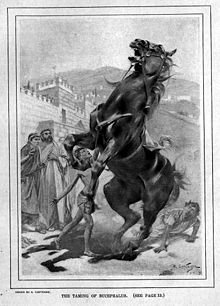Bucephalos

Bukephalos (from ancient Greek βουκέφαλος buképhalos , German ' ox- headed ' - probably due to the shape of the brand, Latinized Bucephalus ) was the warhorse of Alexander the Great . It is considered the most famous horse in ancient times . Alexander got it when he was ten or twelve years old. Bucephalus lived from around 355 to June 326 BC. Chr.
Historical mention
According to Plutarch's story (who, however, probably consulted less credible sources in many respects), this horse is said to have been offered for sale to Philip II , Alexander's father, in Dion , but nobody was able to ride it. Alexander had observed the attempts of the others and found that the horse was afraid of the shadow of rider and horse. He placed it so that it couldn't see its shadow, which allowed him to ride the horse. Philipp bought it for the completely inflated price of 13 talents . The monthly salary for 1,500 soldiers could have been paid for the equivalent value.
According to this story, Alexander was the only one who could ride this horse. It accompanied him in all of his battles. The animal is said to have become very old, around 30 years. After he drowned during the Battle of the Hydaspes , Alexander founded the city of Alexandreia Bukephalos , today's Jhelam in the Pakistani province of Punjab , on the battlefield in his honor . Alexander buried it splendidly and erected a monument in honor of the horse at the place of death.
There is no reliable information about race, color, drawing and gender. There are only conjectures about the name Ochsenkopf and the cause of death. Numerous monuments were placed on the horse, such as in Thessaloniki , Naples (Alexander am Granikos) and in Rome in front of the Quirinal Palace . Some sources refer to it as a unicorn .
Literary mention
In Bernhard Schlink's novel “ Der Vorleser ” (1995), the young protagonist Michael Berg suggests the Germanized diminutive of the name Bukephalos (“Bukeffelchen”) as a possible nickname for Hanna Schmitz, with whom he has entered into a relationship. In Kafka's story " The New Advocate " (1920) the protagonist is Dr. Bucephalus.
Bucephalus ( Alexander mosaic , detail)
Images of the two on a Macedonian bronze coin of Severus Alexander
The Taming of Bucephalus in Edinburgh
literature
- Peter Green: Alexander of Macedon. 356 - 323 BC A historical Biography (= Hellenistic Culture and Society. 11). 1st paperback print. University of California Press, Berkeley CA et al. 1992, ISBN 0-520-07165-4 .
- Bucephalas. In: The Oxford Classical Dictionary . 3rd edition. Oxford University Press, Oxford et al. 1996, ISBN 0-19-866172-X , p. 264.
Web links
- Hans Heiner Buhr: Bucephalus - legends and secrets about a horse. ( Memento from September 23, 2008 in the Internet Archive ).
supporting documents
- ^ Karen Duve , Thies Völker: Lexicon of famous animals. Eichborn, Frankfurt am Main 1997, ISBN 3-8218-0505-6 , p. 108.
- ^ Bernhard Schlink : The reader. Roman (= Diogenes-Taschenbuch. 22953). Diogenes, Zurich 1997, ISBN 3-257-22953-4 , p. 69 (Chapter 14).



